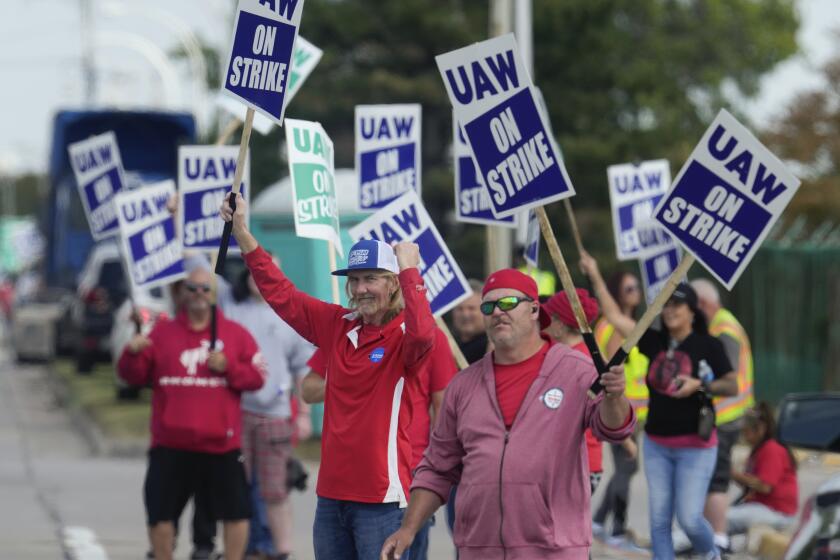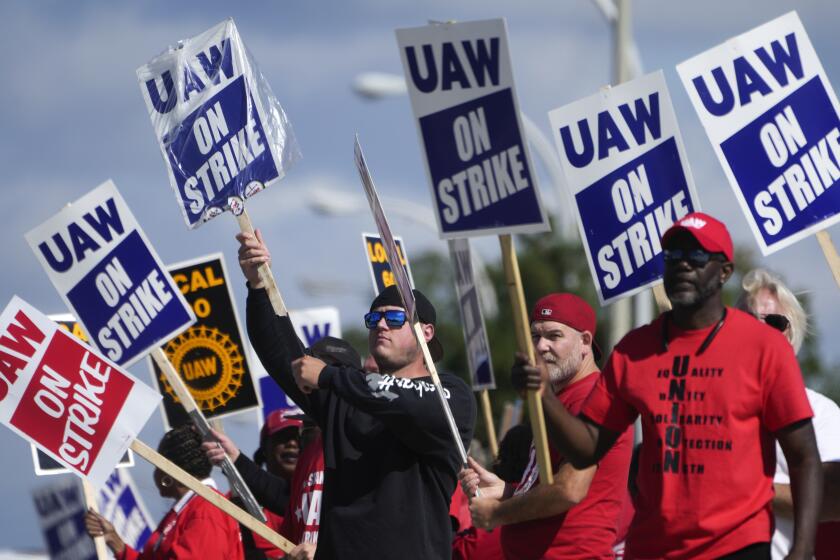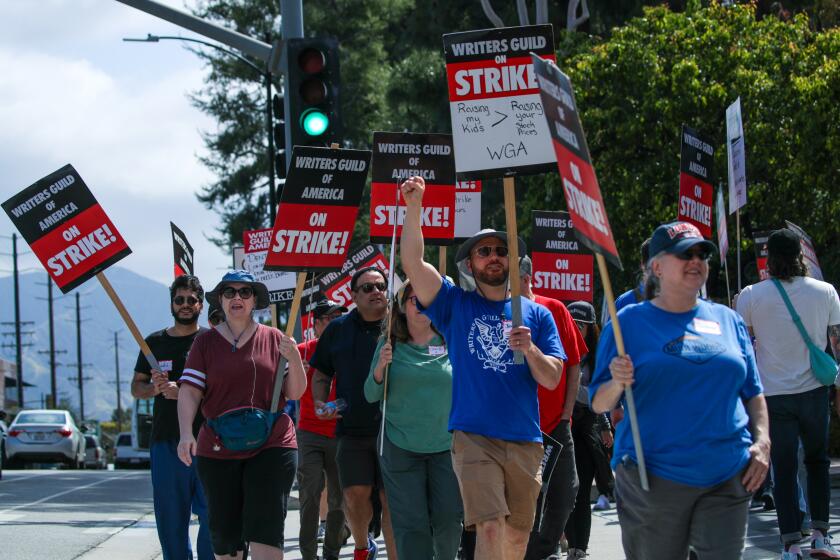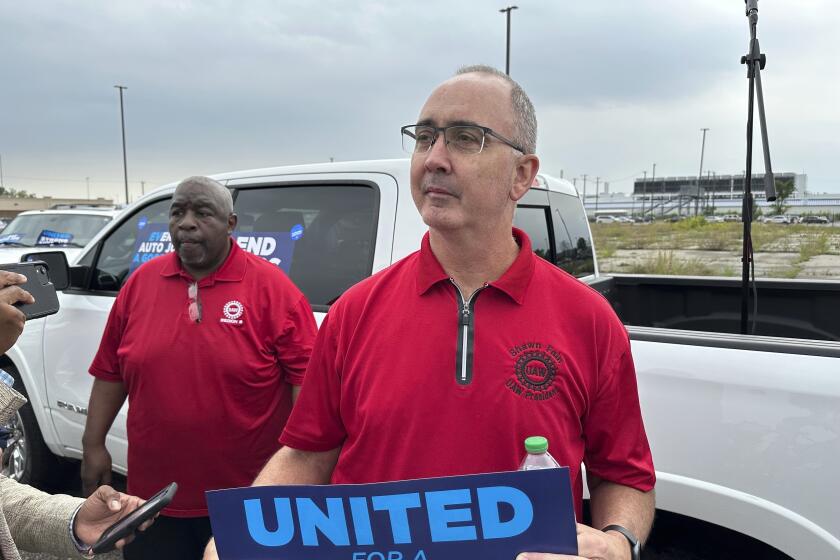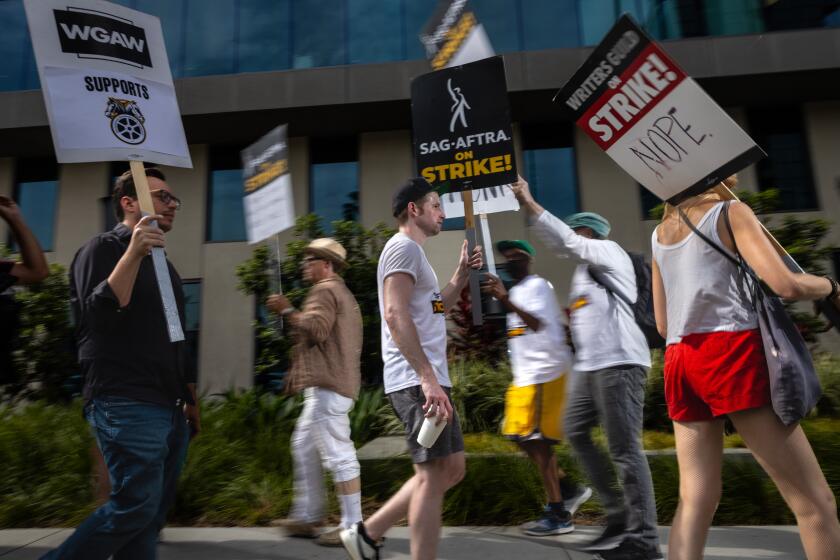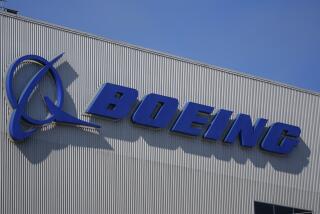Autoworkers’ strikes spread to 38 locations in 20 states, targeting Stellantis and GM
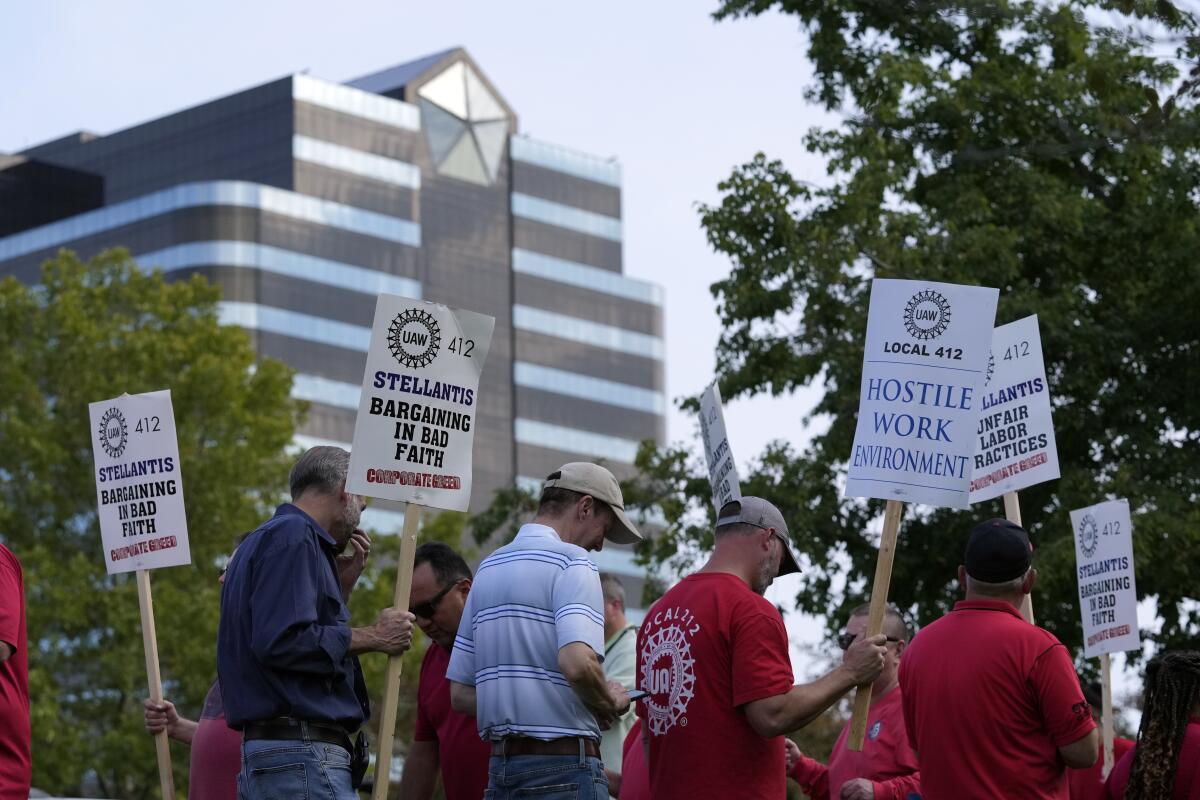
- Share via
The United Auto Workers union expanded its strikes against major carmakers Friday, walking out of 38 parts-distribution centers operated by General Motors and Jeep and Ram owner Stellantis in 20 states.
President Biden said on X, formerly known as Twitter, that he will visit Michigan on Tuesday “to join the picket line and stand in solidarity with the men and women of UAW as they fight for a fair share of the value they helped create.”
Ford was spared additional strikes because the company has met some of the union’s demands during negotiations over the past week, UAW President Shawn Fain said during an online presentation to union members.
“We’ve made some real progress at Ford,” Fain said. “We still have serious issues to work through, but we do want to recognize that Ford is showing that they are serious about reaching a deal. At GM and Stellantis, it’s a different story.”
Fain said GM and Stellantis, the successor to Fiat Chrysler, have rejected the union’s proposals for cost-of-living increases, profit sharing and job security, and “are going to need some serious pushing.”
GM said it has presented five “historic” offers covering wages and job security.
The auto workers’ strike against Detroit’s Big Three will enter its fifth day on Tuesday.
“Today’s strike escalation by the UAW’s top leadership is unnecessary,” the company said in a statement. “The UAW leadership is manipulating the bargaining process for their own personal agendas.”
Stellantis said it made “a very competitive offer” Thursday that would pay all current full-time hourly employees between $80,000 and $96,000 within four years and seven months and allow “workforce stability” during that time. The company said the UAW has not responded.
Instead of targeting more production plants Friday, the UAW went after centers that distribute parts to car dealer service departments. That could quickly drag consumers into the middle of the fight if dealers run short of parts.
The UAW said the new walkouts will affect 5,600 workers on top of the nearly 13,000 who began strikes last week at three Ford, GM and Stellantis assembly plants. Those original strikes will continue, the union said. Among the new targets are two locations in Southern California: a GM parts distribution center in Rancho Cucamonga and a Stellantis facility in Ontario.
The UAW is continuing to avoid targeting plants that make Detroit’s bestsellers, such as the Ford F-150 and Stellantis’ Ram pickups, which represent outsize shares of the companies’ revenue and profit. That represents a union strategy to gradually increase the pain of a strike on the automakers. However, the industry’s supply chain is so integrated that even hitting lower-profile plants cuts into production.
The money automakers spent on stock buybacks to raise shareholder profits, rather than on wages or investments in a green future, helps explain why workers are stepping up the pressure.
Deutsche Bank analysts estimated Friday that GM, Ford and Stellantis have lost production of more than 16,000 vehicles since the strike started last week at a Ford assembly plant near Detroit; a GM factory in Wentzville, Mo.; and a Jeep plant run by Stellantis in Toledo, Ohio. Anderson Economic Group, a consulting firm in Michigan that tracks the industry, estimated Friday that the three big automakers have suffered economic losses of more than $1.6 billion.
The carmakers and some of their suppliers have laid off about 6,000 workers in moves they say are related to the strike. GM shut down a factory in Kansas that relies on parts stamped at the Wentzville plant.
Still, the effect is not yet being felt on car lots around the country — it will probably take a few weeks before the strike causes a significant shortage of new vehicles, according to analysts. Prices could rise even sooner, however, if the prospect of a prolonged strike triggers panic buying.
In bargaining, the union is pointing to carmakers’ huge recent profits as it seeks wage increases of 36% over four years. The companies have offered a little over half that amount.
“We aren’t getting paid what we are supposed to. I feel like our CEO is getting all our money,” said Antione Turner, who walked off his job Friday at a GM customer care center in Belleville, Mich.
The recent run of wins in the Legislature for organized labor was remarkable. Now Gov. Newsom must decide if union-backed bills will become law.
Turner said that after working there for 10 years, he makes $31 an hour. On the same picket line, Shelton Matthews, who started at GM three years ago, makes $20 an hour because the company’s tiered wage structure means lower pay for new workers.
“Pay disparity is the key issue” in the strike, Matthews said. “You’re doing, if not harder work, the same work as the person next to you with significantly less pay.”
The companies say they can’t afford to meet the union’s demands because they need to invest profits in a costly transition from gas-powered cars to electric vehicles. They have dismissed out of hand some of the demands, including 40 hours’ pay for a 32-hour work week.
Fain said that Ford has agreed to some union proposals, including the restoration of cost-of-living wage increases that were dropped several years ago, better profit sharing and improved job security.
A Ford spokesman, Daniel Barbossa, said the company “is working diligently with the UAW to reach a deal that rewards our workforce and enables Ford to invest in a vibrant and growing future.”
As usual, the media and politicians are blaming the possibility of an auto strike on the auto workers union, but company managements are the guilty parties.
“Although we are making progress in some areas, we still have significant gaps to close on the key economic issues,” he said.
Rather than bargain with one company and set a pattern for contracts at the other two, the UAW has been negotiating simultaneously with all three Detroit giants. By favoring Ford after a week of talks, the UAW moved closer to its traditional bargaining pattern: getting the best deal it can from one company, then expecting the others to match it.
Fain had promised all week to escalate the strike if there was no significant progress in negotiations. Targeting the parts-distributions centers could inflict quick pain on GM and Stellantis, said Daniel Ives, an analyst with Wedbush Securities.
“The UAW is going for the gut punch as this strike gets a lot nastier,” Ives said. He called it “a very strategic and risky poker move by the UAW.”
Other industry observers said that dragging current owners of GM and Stellantis vehicles into the fray will backfire on the union.
Los Angeles is sitting at the vanguard of two trends: increasingly expensive housing and an increasing amount of cross-union solidarity.
“People who have a car that they need to repair will not be sympathetic to the UAW when they can’t get the car fixed and can’t get to work,” said Eric Gordon, a business professor at the University of Michigan.
Even with Friday’s expansion, the strikes involve only a little over 10% of the UAW’s 146,000 members. That will make the union’s $825 million strike fund last longer, as most members will keep working under the expired contract and pay into the fund. However, the longer the strike lasts, the greater the risk of dissension between workers who will keep collecting full paychecks and those getting $500 a week from the union.
Fain believes that most of the public is on the union’s side. He invited anyone who supports the union — “all the way up to the president of the United States” — to join strikers on the picket lines.
Fain had previously seemed lukewarm at best about a Biden visit, saying that the strike was the union’s fight, not the president’s.
Biden’s visit Tuesday would come one day before the leading contender for the Republican nomination, former President Donald Trump, plans to speak to union members in Detroit.
More to Read
Inside the business of entertainment
The Wide Shot brings you news, analysis and insights on everything from streaming wars to production — and what it all means for the future.
You may occasionally receive promotional content from the Los Angeles Times.
